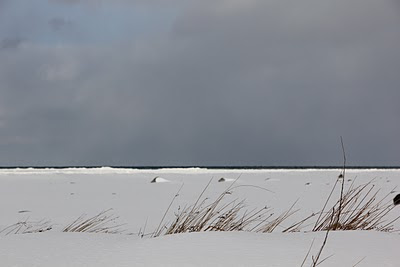This is a photo from a recent trip to Prague, and the thought-provoking thing about it is the way that water functions in defining urban space. The public part of a community - its streets - are in a way a sort of negative space - they receive their identity by being the little ribbons of non-private property that spider-web through the cityscape. If this is their theoretical identity, then their physical identity is similar - they gain definition from the walls, plazas, and facades that rise up on either side. A street needs to be contained to make pedestrians comfortable. In the same way that diners will choose the corner booth over a center table, people are instinctively more comfortable in a defined street space built to a human scale. Perhaps it creates a sort of safety. Perhaps its coziness evokes the womb. But regardless, this principle in a large way explains the death of the American landscape - as freeways were built through communities like Detroit and New Haven the streets ceased to be human-scaled and the space ceased to be defined as delimiting buildings moved further and further back to accommodate massive parking lots. Cities were no longer cityscapes built for people but moonscapes built for the automobile. So maybe that's one reason so many tourists flock to the old town of Prague - to reclaim the feeling of comforting enclosure that can be experienced in its narrow streets.
This concept of delimitation is part of what's so important about water. The city of Prague is built on a series of bends in the Vltava river, so each riverbend forms a different community as the water effectively delimits the neighborhood from its surroundings. Without these natural frames, Prague's micro-communities would have less individual identity. Water is important because of its effect on the eye - ironically it is both limiting and freeing as it walls off spaces and allows room for the eye to stretch.
Incidentally, this photo was taken during a spring flood, and the island on which I was standing was quickly thereafter engulfed by the waters of the Vltava. I'm not exactly sure what implications that has for "defining space." Consider it food for thought.
Thursday, January 27, 2011
Monday, January 24, 2011
C L O U D S
John Constable's cloud sketches, done in the early 1820's in England, are among my favorite works of art (below - and many more to come). He observed and recorded one of the most transient subjects - the sky, notating the precise details of time, temperature and wind direction. The colors are gorgeous and earthy, and the brushstrokes loose and spontaneous.
It hardly compares, but when the light and conditions are just right, it's almost possible to capture an image over the lake that comes close (below, 2). I guess the onus is on me to take a momentary breather from driving kids to lacrosse practice and piano lessons and paint. There's probably an important lesson to be learned from Constable. He didn't have the luxury of seeing a beautiful thing and putting it off. If the clouds were right, they were right, and he had to paint them then and there. There's not really an excuse for putting off your art - you can always procrastinate by the insidious method of "I'll do this once I've finished paying bills / doing housework / other mundane chores", but the truth is that this moment never comes. So there's a New Year's resolution - to prioritize art over procrastination. The dishes will wash themselves for now.

It hardly compares, but when the light and conditions are just right, it's almost possible to capture an image over the lake that comes close (below, 2). I guess the onus is on me to take a momentary breather from driving kids to lacrosse practice and piano lessons and paint. There's probably an important lesson to be learned from Constable. He didn't have the luxury of seeing a beautiful thing and putting it off. If the clouds were right, they were right, and he had to paint them then and there. There's not really an excuse for putting off your art - you can always procrastinate by the insidious method of "I'll do this once I've finished paying bills / doing housework / other mundane chores", but the truth is that this moment never comes. So there's a New Year's resolution - to prioritize art over procrastination. The dishes will wash themselves for now.


L O L L
After many years of oiling our teak outdoor furniture and covering it in the winter to protect it from the elements, we ordered chairs and benches from Loll Designs. The design is simple, functional and comfortable, and it can be left outside in all weather, as you can see all too hilariously below. Not to mention it's made of 100% recycled materials. www.lolldesigns.com

Subscribe to:
Comments (Atom)

